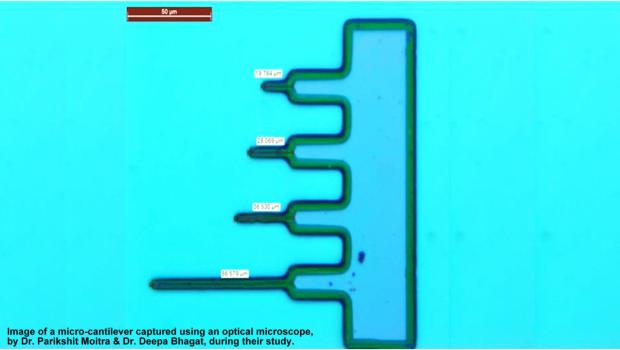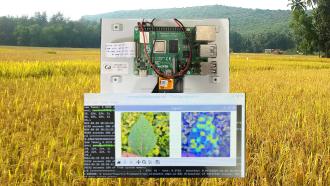
Photo Credit: Dr. Parikshit Moitra (IACS) & Dr. Deepa Bhagat (NBAIR)
A team of scientists from Bangalore led by Professor Santanu Bhattacharya have developed an electronic device that can detect the presence of chemical mating signals of two crop pests - Helicoverpa armigera (Hubner) and Scirphophaga incertuals (Walker). Notorious for infecting more than ~150 crops across the world, these two insects are particularly rampant in South Asia. The female insects of these species release chemicals known as ‘sex pheromones’ in the air for mating. The newly developed device can detect this chemical, even at extremely low concentrations, thus prompting preventive measures to avoid crop losses.
Every year, plant pests reduce global crop yields by a staggering 20% - 40%. The overuse of insecticides and pesticides has shown to develop pest resistance and arguably affect the environment as well. Innovative farming practices such as planting insect-attracting companion crops along with main crop (trap cropping) and growing genetically modified crops for pest resistance (transgenic cropping) have seen only limited success. An effective and lasting solution without any adverse side-effects calls for innovative and non-invasive measures. As this team of scientists discovered, the answer lay in the life-cycle of the pests under consideration.
Helicoverpa armigera (Hubner) and Scirphophaga incertuals (Walker) are infamous for their damage mainly to the cotton and rice crops among many others. Moths of both of these species lay eggs on crops, and the larvae that may hatch devour and destroy the crop. One way to stop this would be to discourage the laying of eggs by using techniques like pheromone traps for the male insects. Since sex pheromones are unique and carry a distinct chemical signature of each species, pheromone traps rely on trapping male insects in a physical contraption by smearing it with the insect's signature pheromone. However, this is a tedious and expensive technique, also leading to unnaturally high exposure to pheromone chemicals for the farmers.
The researchers of the study decided on a different approach by building a portable and highly sensitive device that can detect even minute quantities of sex pheromones in the air, when naturally secreted by pests. They used microelectromechanical system (MEMS) technology that has micron-sized electronic devices with moving parts, routinely used in gyroscopes and health monitoring sensors. This research marks the suitably functionalized MEMS devices for the first time to selectively detect pest pheromones.
“The silicon dioxide based MEMS devices that we fabricated have no selectivity on their own,” points out Prof. Bhattacharya, the senior author of the study. “It is the chemical functionalization steps, developed by us after many standardizations, that make these devices specific to the female sex pheromones,” he reiterates. Prof. Bhattacharya and his team in collaboration with Prof. Rudra Pratap of the Centre for Nano Science and Engineering (CeNSE) conducted these experiments at the Department of Organic Chemistry in Indian Institute of Science (IISc), Bangalore.
Once the researchers fabricated the devices, they subjected them to a unique chemical treatment starting with the addition of free amine groups. These amine groups bond with the aldehyde groups in the pheromone via a carbon-nitrogen double bond, known as Schiff base linkage. Though this made the devices selective to the target pheromones, multiplying the number of available amine groups through subsequent steps in the treatment was critical. This enabled detection of minute quantities of pheromones in situ. Each device could detect pheromone mass as low as 5 femtograms (1 femtogram = 10-15 gram). Additionally, these devices were found to be stable for Indian weather conditions.
“We tested the device’s durability in the temperature range between 0 to 60 oC and in extreme humidity. In some cases, the devices were dipped in water, dried and then checked. They were active even in that condition,” remarks Dr. Moitra, the first author of the paper published in Scientific Reports. To simulate a real field condition, the devices were tested in a large box of tomato plants with male and female Hubner moths. “When checked every 6 hours, the functionalized devices clearly showed the presence of pheromones each time,” points out Dr. Bhagat. Also, these devices are robust enough to be chemically cleaned and re-used. “These devices can be reused at least for five times,” notes Dr. Moitra.
When tested in the presence of interfering pheromones from various other insects present in an agricultural field, the device responded selectively only to pheromone chemicals from Hubner and Walker. Although the results seem promising for farmers of cotton and rice who fight crop losses due to pests, they are currently in their nascent form and need to be developed into a handy product for wide usage. “Presently, we need laser doppler vibrometer (LDV) to analyze data from these devices after exposure to pheromones. We are now developing a miniature version of the whole system for easy deployment and transportation,” signs off Dr. Moitra.






